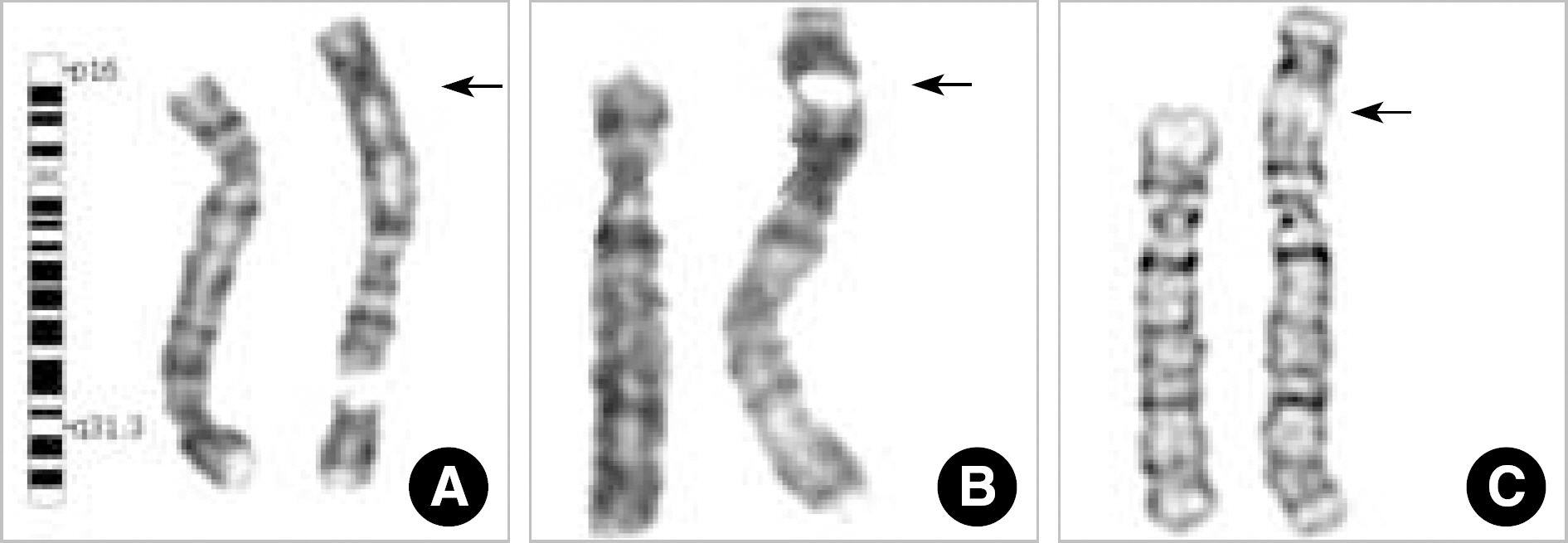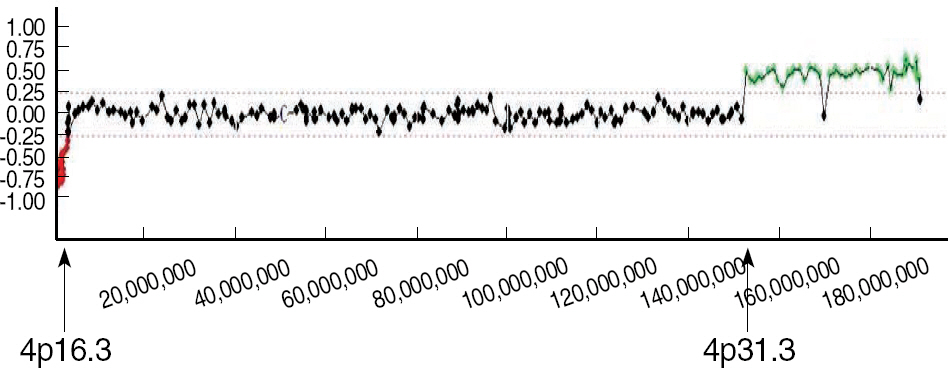Korean J Lab Med.
2010 Feb;30(1):89-92. 10.3343/kjlm.2010.30.1.89.
Recombinant Chromosome 4 with Partial 4p Deletion and 4q Duplication Inherited from Paternal Pericentric Inversion
- Affiliations
-
- 1Department of Laboratory Medicine, Sanggye Paik Hospital, Inje University College of Medicine, Seoul, Korea. soojyoo@hanmail.net
- 2Greencross Reference Laboratory, Yongin, Korea.
- 3Department of Pediatrics, Sanggye Paik Hospital, Inje University College of Medicine, Seoul, Korea.
- 4Department of Obstetrics and Gynecology, Sanggye Paik Hospital, Inje University College of Medicine, Seoul, Korea.
- KMID: 1096825
- DOI: http://doi.org/10.3343/kjlm.2010.30.1.89
Abstract
- Pericentric inversion of chromosome 4 can give rise to 2 alternate recombinant (rec) chromosomesby duplication or deletion of 4p. The deletion of distal 4p manifests as Wolf-Hirschhorn syndrome (WHS). Here, we report the molecular cytogenetic findings and clinical manifestations observed in an infant with 46,XX,rec(4)dup(4q)inv(4)(p16q31.3)pat. The infant was delivered by Cesarean section at the 33rd week of gestation because pleural effusion and polyhydramnios were detected on ultrasonography. At birth, the infant showed no malformation or dysfunction, except for a preauricular skin tag. Array comparative genomic hybridization analysis of neonatal peripheral blood samples showed a gain of 38 Mb on 4q31.3-qter and a loss of 3 Mb on 4p16.3, and these results were consistent with WHS. At the last follow-up at 8 months of age (corrected age, 6 months), the infant had not achieved complete head control.
Keyword
MeSH Terms
Figure
Reference
-
1.Gardner RJ, Sutherland GR, editors. Chromosome abnormalities and genetic counseling. 3rd ed.New York: Oxford University Press;2004. p. 142–62.2.Rauch A., Schellmoser S., Kraus C., Dorr HG., Trautmann U., Altherr MR, et al. First known microdeletion within the Wolf-Hirschhorn syndrome critical region refines genotype-phenotype correlation. Am J Med Genet. 2001. 99:338–42.
Article3.Cho EH., Park BYN., Cho JH., Kang YS. Comparing two diagnostic laboratory tests for several microdeletions causing mental retardation syndromes: multiplex ligation-dependent amplification vs fluorescent in situ hybridization. Korean J Lab Med. 2009. 29:71–6. (조은해, 박보야나, 조정희, 강유선. 정신지체의 원인인 여러 미세결실증후군의선별검사로이용되는 Multiplex Ligation-Dependent Probe Amplification 로형광동소교잡법의비교평가.대한진단검사의학회지 2009;29:71-6.).
Article4.Shaffer LG., Slovak ML, et al. eds. An international system for human cytogenetic nomenclature (ISCN). 2009. Basel: Karger 2009.5.Engbers H., van der Smagt JJ., van't Slot R., Vermeesch JR., Hochstenbach R., Poot M. Wolf-Hirschhorn syndrome facial dysmorphic features in a patient with a terminal 4p16.3 deletion telomeric to the WHSCR and WHSCR 2 regions. Eur J Hum Genet. 2009. 17:129–32.
Article6.Zollino M., Murdolo M., Marangi G., Pecile V., Galasso C., Mazzanti L, et al. On the nosology and pathogenesis of Wolf-Hirschhorn syndrome: genotype-phenotype correlation analysis of 80 patients and literature review. Am J Med Genet C Semin Med Genet. 2008. 148C:257–69.
Article7.Zollino M., Di Stefano C., Zampino G., Mastroiacovo P., Wright TJ., Sorge G, et al. Genotype-phenotype correlations and clinical diagnostic criteria in Wolf-Hirschhorn syndrome. Am J Med Genet. 2000. 94:254–61.
Article8.Schlickum S., Moghekar A., Simpson JC., Steglich C., O'Brien RJ., Winterpacht A, et al. LETM1, a gene deleted in Wolf-Hirschhorn syndrome, encodes an evolutionarily conserved mitochondrial protein. Genomics. 2004. 83:254–61.
Article9.Bergemann AD., Cole F., Hirschhorn K. The etiology of Wolf-Hirschhorn syndrome. Trends Genet. 2005. 21:188–95.
Article10.Van Buggenhout G., Melotte C., Dutta B., Froyen G., Van Hummelen P., Marynen P, et al. Mild Wolf-Hirschhorn syndrome: micro-array CGH analysis of atypical 4p16.3 deletions enables refinement of the genotype-phenotype map. J Med Genet. 2004. 41:691–8.
Article11.Kagitani-Shimono K., Imai K., Otani K., Kamio N., Okinaga T., Toribe Y, et al. Epilepsy in Wolf-Hirschhorn syndrome (4p-). Epilepsia. 2005. 46:150–5.
Article12.Huhta JC., Smallhorn JF., Macartney FJ., Anderson RH., de Leval M. Cross-sectional echocardiographic diagnosis of systemic venous return. Br Heart J. 1982. 48:388–403.
Article13.Carrascosa RM., Garcia MO., Vidal CA., Cabezas TM., Gonzalvez PJ. Partial duplication of chromosome 4q (q31, q35): auriculo-acro-renal syndrome. An Pediatr (Barc). 2008. 68:361–4.14.Cui YX., Wang YH., Hao LJ., Hou L., Li W., Huang YF. Partial trisomy 4q: a case report. Chin Med J (Engl). 2006. 119:1136–9.
Article15.Halal F., Vekemans M., Chitayat D. Interstitial tandem direct duplication of the long arm of chromosome 4 (q23-q27) and possible assignment of the structural gene encoding human aspartylglucosaminidase to this segment. Am J Med Genet. 1991. 39:418–21.
Article16.Jeziorowska A., Ciesla W., Houck GE Jr., Yao XL., Harris MS., Truszczak B, et al. Cytogenetic and molecular identification of a de novo direct duplication of the long arm of chromosome 4(q21.3—>q31.3). Am J Med Genet. 1993. 46:83–7.17.Garcia-Heras J., Martin J. A rec(4) dup 4p inherited from a maternal inv(4)(p15q35): case report and review. Am J Med Genet. 2002. 109:226–30.
Article
- Full Text Links
- Actions
-
Cited
- CITED
-
- Close
- Share
- Similar articles
-
- Beckwith-Wiedemann Syndrome and Jacobsen Syndrome Caused by 11pter Duplication and 11qter Deletion Inherited from Paternal Pericentric Inversion
- Terminal Deletion of the Chromosome 4q with Hemivertebra: Case Report
- Prenatal diagnosis of 4p deletion syndrome: A case series report
- Prenatal detection of de novo inversion of chromosome 9 with duplicated heterochromatic region and postnatal follow-up
- A Case of 4q Deletion with Partial Agenesis of Corpus Callosum




